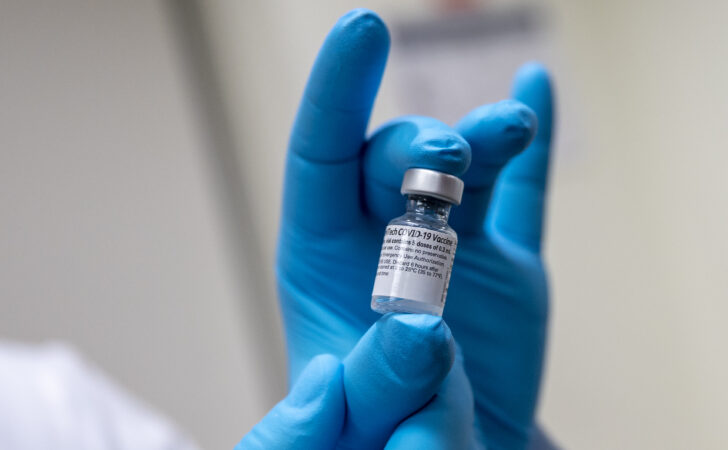Are the nanoparticles in Covid vaccines capable of harming us?

Again and again, the argument comes up that the currently used Covid vaccines contain nanoparticles. This is true, but is it dangerous?
"A nanoparticle is being shot into your bloodstream at high speed," reads an audio message warning about the Covid vaccine.
It almost sounds like someone is detonating a nuclear bomb in my bloodstream.
Yet: what is a nanoparticle? First of all, "nano" is nothing more and nothing less than a size designation. Nanoparticles are particles that are between one and one hundred nanometers in size. One nanometer corresponds to 0.000 000 001 meters, or one billionth of a meter. The term "nano" is derived from the Greek "nanos", which means "dwarf". In Spanish, the dwarf is also called "enano". A nanoparticle is therefore initially simply a dwarf-sized particle.
The nanoparticles in the Covid vaccine are tiny fat globules, or more precisely lipid globules. These form the packaging for the vaccine-active mRNA. This is because it is very unstable. It would not be possible to draw it up in a syringe and inject it into an upper arm. It would disintegrate before you could do that. To protect it, the mRNA is wrapped in these dwarf-sized lipid beads. In other applications, too, therapeutically active substances are now transported in small nano-transporters to the correct site of action in the body.
So the statement is true: there are nanoparticles in the form of lipid globules in the Covid vaccine. But, are these dangerous? No. Because, as I said, "nano" only says something about the size of the particles.
Natural nanoparticles
Nanoparticles also occur naturally in many foods: for example, in milk, in the form of casein, the protein from which cheese is made. It balls up into small nanoscale spheres.
The only new thing about such natural nanoparticles is that they are called "nano". After all, their properties have been used in milk processing for thousands of years.
Nanoparticles as food additives
But there are also nanoparticles that are artificially added to food. For example, titanium dioxide, which is used as a food additive E171 to give milk products, ice cream, chewing gum and tablets a white color. By the way, titanium dioxide is also found in emulsion paint on the walls of your apartment. Or silicon dioxide, also known as silicic acid. It's used in seasonings, food supplements, table salt or sliced cheese. It is a carrier for dyes, flavors and plasticizers in pharmaceuticals and cosmetics. And finally, nano-silica is also used in organic foods and baby food. These substances are harmless in food. But because they are so small and go virtually everywhere in our bodies, there are limits on their use.
Titanium dioxide is also found in some high SPF sunscreens. Various studies indicate that nanoscale titanium dioxide cannot penetrate the body through healthy skin. Nevertheless, caution is advised.
Dangerous nanoparticles
But there are also clearly dangerous nanoparticles. For example, particulate matter from heating fumes or the abrasion of brake pads on cars or trains. These are potentially hazardous to health. But not so much because they are "nano," but because they typically consist of soot or metals. Their tininess allows these soot and metal particles to go virtually anywhere in our bodies and possibly accumulate in organs. So it is not primarily the nanoscale that makes particles dangerous, but the substance they are made of.
Nanomaterials are also used in many other places. For the refinement of surfaces, for example. By coating them with nanoscale particles, they become more scratch-resistant, dirt- and water-repellent, or antibacterial. In this application, the "nano" refers less to the type of material and more to the thickness or thinness of the applied layer. By the way, you have such a nano-surface in your fingers every day, maybe even at this very moment when you are reading this text. The surface of your smartphone is nanocoated.
And the chip in the vaccine?
That leaves the thing that is supposed to be administered to us with the vaccine and serves to monitor us: the chip. Pardon, the microchip.
What is micro or nano? There is a difference in dimensions. The world's smallest chip was presented in May this year by researchers at Columbia University.
And it is actually injected into the human body. And it is even used for monitoring! But it is not included in the Covid vaccine. In experimental applications, it can measure various parameters in our body - temperature, blood pressure, glucose, which can then be read from the outside without contact. But again, the claims of the Corona myths are not true: the chip cannot connect to the wireless network of mobile telephony. It makes it easier to monitor physiological values of patients. But how big is this "monitoring device"? Huge! About the size of a house dust mite: 0.1 millimeters wide, high and long. In other words, about 1,000 to 10,000 times larger than a nanoparticle. So there is no trace of "nano" - and it is certainly not contained in the vaccine.
Quelle: higgs.ch
Schaden uns die Nanopartikel im Covid-Impfstoff?
Bildquelle: flickr
U.S. Secretary of Defense: 201214-D-BN624-0328